Nanomechanical Characterisation of Thin Films
Traditional material characterisation techniques (eg tensile testing) are not always reliable at the nanoscale. True nanoscale sensitivity and the capacity for quantitative analysis are key to understanding the structure and properties of nanoscale components.
The Hysitron TI 950 TriboIndenter equipped with the performech™ advanced control module delivers the force and displacement sensitivity necesary for testing materials and structures with nanoscale precision.
Blue Scientific is the official Nordic distributor for Hysitron in Finland, Denmark, Iceland, Norway and Sweden. If you have any questions or if you’d like a quote, please get in touch:
Hysitron instruments
Contact us on +44 (0)1223 422 269 or info@blue-scientific.com
Nanomechanical Characterisation of Ultra-Thin Films
Ultra-thin films (hundreds of nanometers or less) are an excellent example of a material requiring nanoscale characterisation. In materials development it is essential to understand the relationship between processing parameters, modeling and model confirmation, in order to optimise properties to your requirements. This is relevant in areas including:
- Microelectronics
- Optics and optical coatings
- MEMS devices
- Hard and corrosion resistant coatings
- Photovoltaics
- Shape memory alloys
In-Situ Testing Techniques
- In-situ SPM imaging – Qualitative surface analysis before and after testing. Quantify surface roughness.
- Nanoindentation – Quantitative material properties including hardness, modulus and stiffness, as well as depth profiling.
- Ramping force nanoscratch – Quantification of film delamination/breakthrough.
- Reciprocating nanoscratch – Tribology, friction, and wear failure.
- ScanningWear – Wear resistance and wear volume quantification.
Additional in-situ nanomechanical characterisation techniques can further reveal even more information about ultra-thin films. For example, Modulus Mapping analyses the quantitative mechanical properties of the film surface ( to a depth of 1-2 nm). This can overcome the hard film on soft substrate effect often observed in these kinds of films. Other techniques include acoustic emission sensing, nanoscale electrical contact resistance characterisation and fracture toughness measurement. All of these techniques can be performed with Hysitron nanoindentation systems.
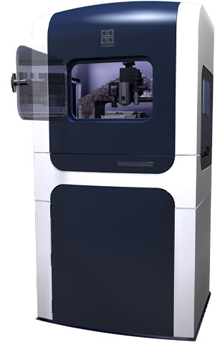
The Hysitron TI 950 TriboIndenter equipped with the performech advanced control module provides the force and displacement sensitivity required to test materials and structures down to the low end of the nanoscale.
- Full range of characterisation techniques
- Automated staging and testing routines
- In-situ SPM imaging
Nanotribology and Friction
In this example, constant force nanoscratch tests were conducted on (100) Si and fused quartz. The same nanoscratch transducer and conospherical diamond probe was used for both tests.
The nanoscratch results below reveal subtle but discernable differences in nanoscale tribological behaviour and friction between samples. A stick-slip tribological phenomena is observed for both materials. However the periodicity and amplitudes of respective friction plots from performech tests are noticeably different. There are changes in both friction magnitude and amplitude of the sinusoidal trend during scratches. This suggests the presence of subtle surface inhomogeneities, revealed by the improved lateral noise of performance tests with the performech control module.
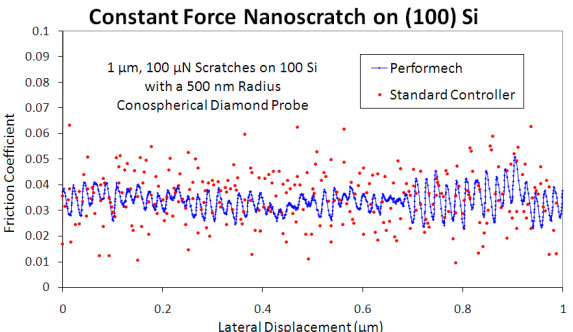
Nanoscratch tests on (100) Si, revealing nanoscale tribological phenomena.
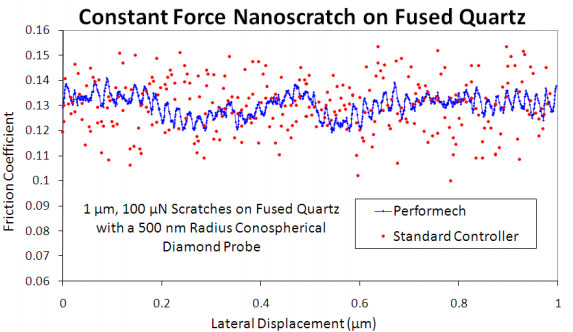
Nanoscratch tests on fused quartz. These reveal subtly different nanoscale tribological behaviour than (100) Si.
Ramping Force Nanoscratch
Delamination/Breakthrough on Ultra-Thin DLC Films
The previous example used constant nanoscratch to show absolute friction magnitudes. Ramping force scratches can also be performed on ultra-thin films. Distinct changes in the force/displacement/friction curve profile caused by delamination or breakthrough are identified as critical events. These can then be quantified for further material characterisation studies.
In this example, ramping force nanoscratch tests were performed on ultra-thin DLC films in hard disk drives. Critical breakthrough and delamination events were pinpointed and quantified. Again, both performech and standard control system data are shown for comparison.
Subtle changes in the friction profile displayed in the performech tests corresponded to critical delamination/breakthrough events. Comparative friction plots from the performech and standard control system arealso shown below. A critical breakthrough/delamination event is highlighted in the performech nanoscratch friction data.
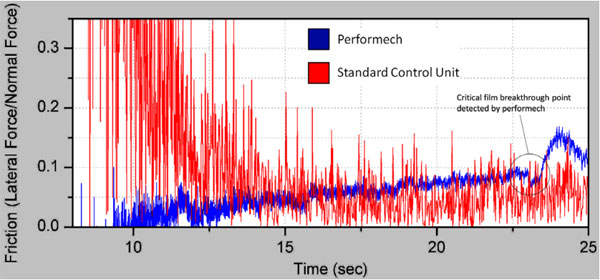
Friction data from ramping force nanoScratch tests on protective ultra-thin DLC film. The Performech data highlights a critical film breakthrough event.
Reciprocating Nanowear
Nanotribology and Failure on Ultra-Thin TiN Thin Films
Multiple cycle wear testing with nanoscale sensitivity and precision delivers useful nanotribological data that cannot be obtained using standard macro- and micro-scale wear testing methods.
In this example, reciprocating nanowear tests were performed on ultra-thin 50 nm TiN films using the performech. The plots below show friction and normal displacement on a colour scale, versus lateral position and reciprocating scratch segment. They show an event and continued wear of the underlying substrate layer.
The breakthrough event at segment 14 is marked by distinct changes in friction and normal displacement. The probe then continues to wear into the substrate material.
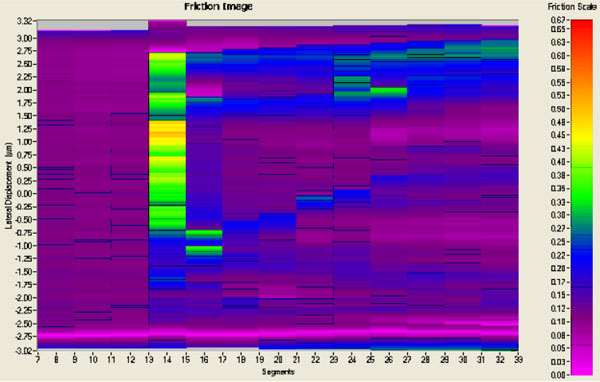
TriboImage plot of friction from a reciprocating nanowear test on ultra-thin TiN film.
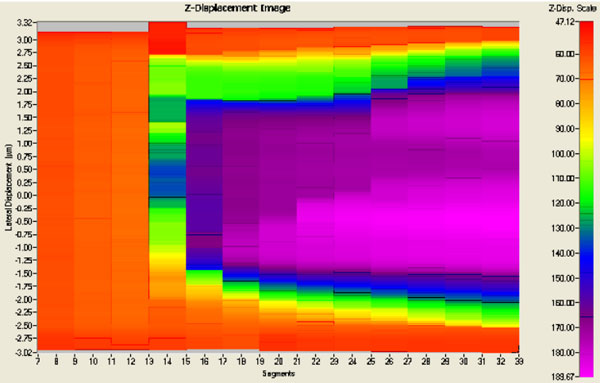
TriboImage plot of normal displacement from a reciprocating nanowear test on ultra-thin TiN film.
Further Information
For more information about the Hysitron TI 950 TriboIndenter, please get in touch:


